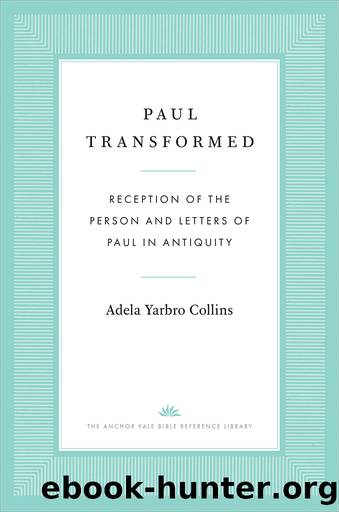Paul Transformed by Adela Yarbro Collins;

Author:Adela Yarbro Collins;
Language: eng
Format: epub
Publisher: Yale University Press
Published: 2022-06-15T00:00:00+00:00
5
Paulâs Transformation from Suffering Apostle to Saint and Martyr
This chapter deals with an autobiographical topic: the persecutions, hardships, and other types of suffering that Paul experienced during his lifetime. Paul recounts these experiences in his letters in order to teach about their significance and to instruct his audience about how they should think and behave when they suffer the same or similar things. This autobiographical material is transformed into biographical and hagiographical texts by later writers and into practices after Paulâs death that venerate him as a saint and martyr.
Paulâs Self-Presentation as Suffering Apostle
Paul speaks about his own sufferings most often in 2 Corinthians and 1 Thessalonians.1 One main type of suffering includes insults, physical violence, and imprisonment in response to his proclamation of the gospel. Another type refers to the hardships that Paul suffers as a consequence of his itinerant lifestyle, which is necessary to fulfill his goal of proclaiming the gospel throughout the Mediterranean world. He uses a variety of terms for the various kinds of persecution and hardships he experienced.2
Opposition and Persecution: 1 Thessalonians
Paul refers to his suffering already in 1 Thessalonians, his earliest letter. He reminds the members of the newly founded community that, even though he had suffered and been insulted in Philippi before he arrived in Thessalonica, God gave him the courage to proclaim the gospel to them. Furthermore, this God-given courage enabled him to proclaim the gospel in spite of the great opposition he faced in Thessalonica itself (2:2).3 Paul may be praising himself indirectly for overcoming the hardships of suffering, insult, and opposition, as ancient moral philosophers often did. Nevertheless, he attributes his courage and success to God. Furthermore, he does not suffer impassively but experiences Godâs help in the depth of his suffering.4
In this letter Paul also speaks about suffering as characteristic of the experience of the apostles and their communities. He introduces this theme in the opening thanksgiving (1:6) and elaborates it in 2:13â16.5 The members of the community in Thessalonica suffered from their compatriots the same kind of persecution that Paul and the congregations of Judea suffered from theirs (2:14, 15a). This kind of persecution was likely the reason Paul sent Timothy, and it was probably the subject of the previous teaching Paul mentions in that context (3:2â4). When Paul states his concern that no one in the Thessalonian community be shaken âby these tribulationsâ (á¼Î½ Ïαá¿Ï θλίÏεÏιν in 3:3), he takes up the topic of persecution and opposition introduced earlier.6 Paul claims that in his previous teaching he informed the Thessalonians that this kind of tribulation, namely, persecution and opposition, is an inevitable aspect of the life of those who are âin Christâ (3:3bâ4).7
The Thorn in Paulâs Flesh: 2 Corinthians
In 2 Corinthians Paul refers, somewhat ambiguously, to a âthorn in his flesh.â This thorn is clearly a type of suffering, but it differs from the two main types mentioned above, that is, persecutions that arose in opposition to the proclaiming of the gospel and the hardships that relate to his constant traveling.
Download
This site does not store any files on its server. We only index and link to content provided by other sites. Please contact the content providers to delete copyright contents if any and email us, we'll remove relevant links or contents immediately.
The Five People You Meet in Heaven by Mitch Albom(3456)
Real Sex by Lauren F. Winner(2949)
Name Book, The: Over 10,000 Names--Their Meanings, Origins, and Spiritual Significance by Astoria Dorothy(2925)
The Secret Power of Speaking God's Word by Joyce Meyer(2917)
The Holy Spirit by Billy Graham(2875)
0041152001443424520 .pdf by Unknown(2765)
ESV Study Bible by Crossway(2725)
How The Mind Works by Steven Pinker(2711)
Ancient Worlds by Michael Scott(2607)
Churchill by Paul Johnson(2493)
The ESV Study Bible by Crossway Bibles(2492)
The Meaning of the Library by unknow(2485)
The Gnostic Gospels by Pagels Elaine(2459)
MOSES THE EGYPTIAN by Jan Assmann(2360)
Jesus by Paul Johnson(2293)
City of Stairs by Robert Jackson Bennett(2292)
The Complete Dead Sea Scrolls in English (7th Edition) (Penguin Classics) by Geza Vermes(2222)
Ancient Near Eastern Thought and the Old Testament by John H. Walton(2183)
The Nativity by Geza Vermes(2164)
